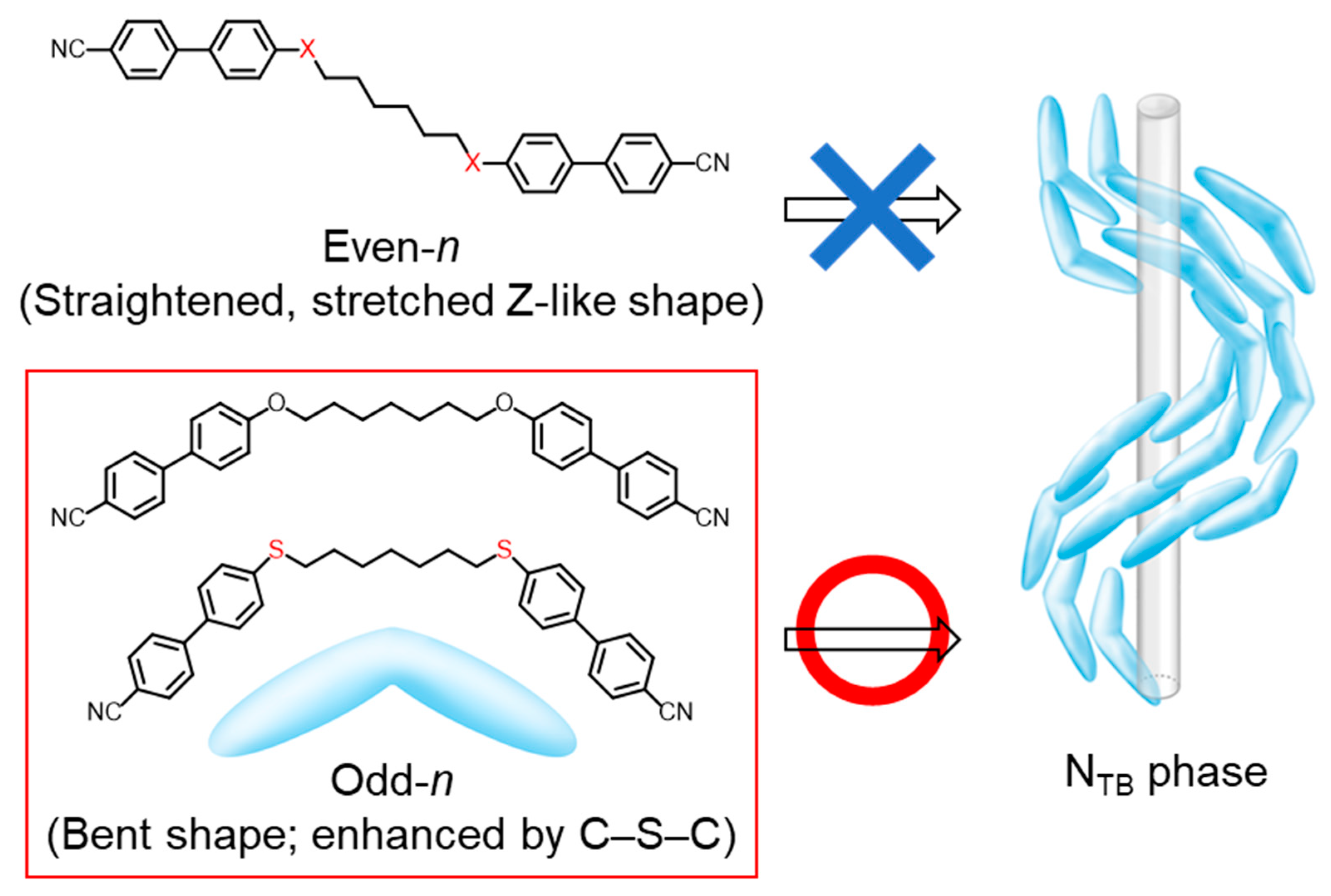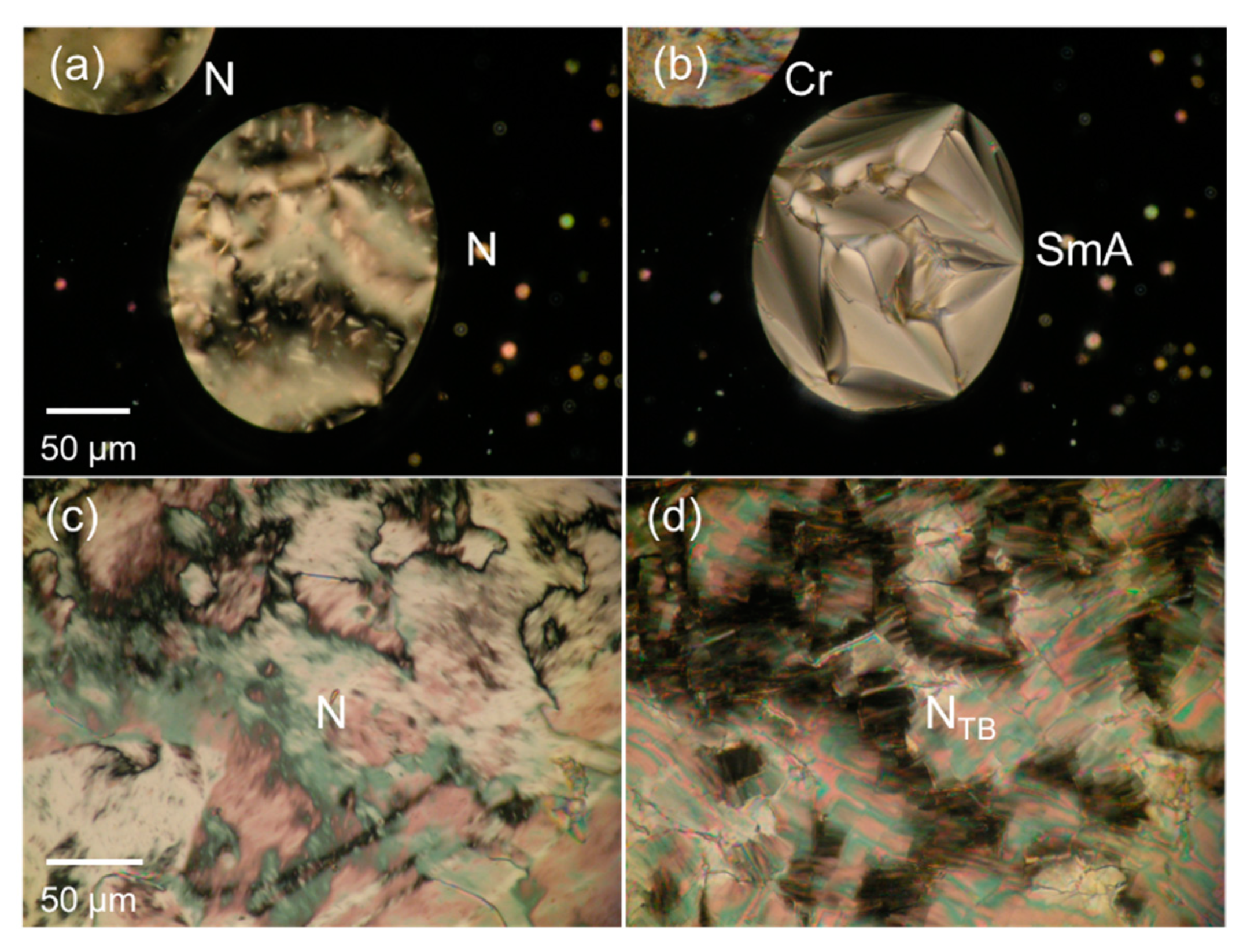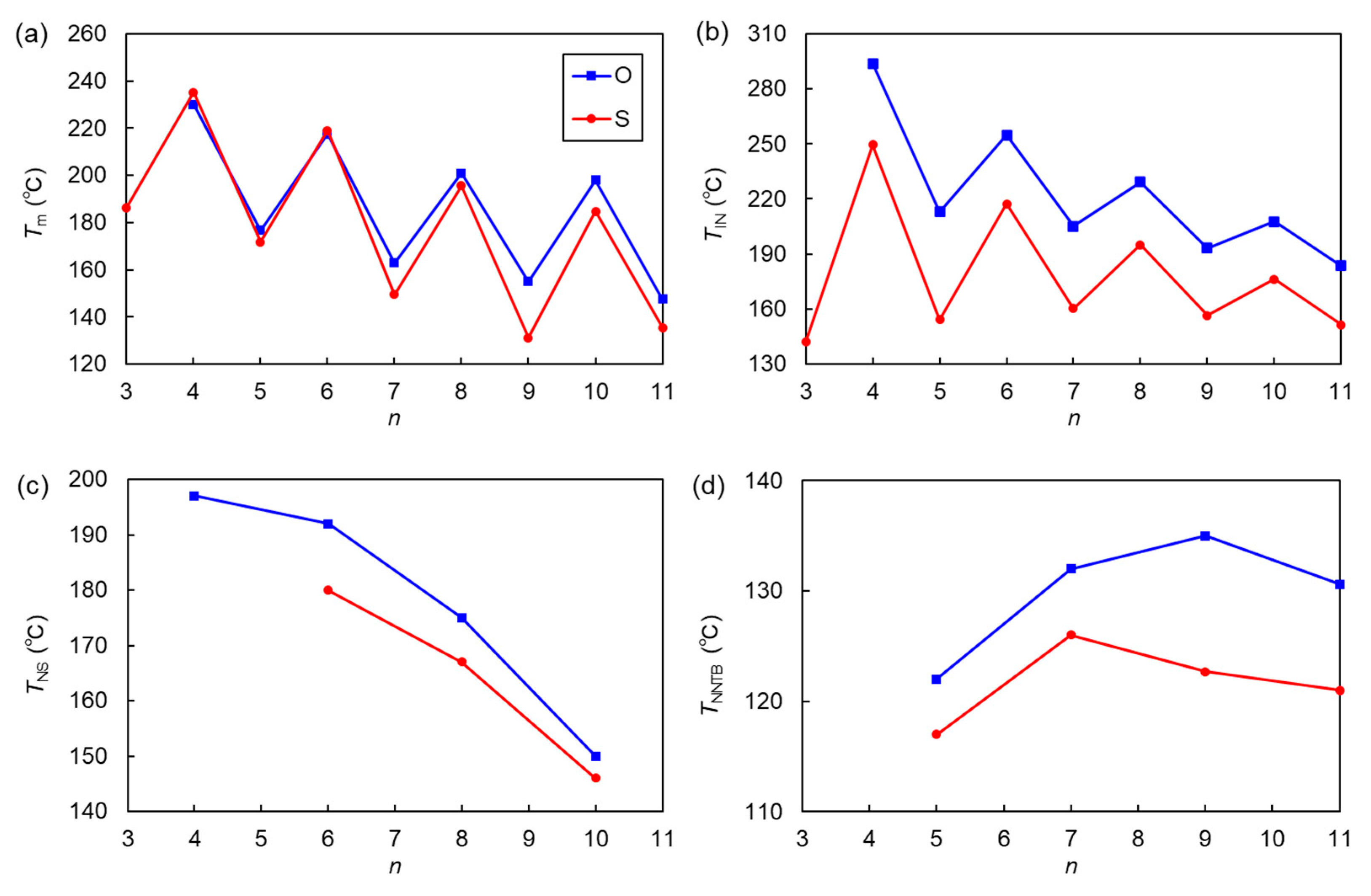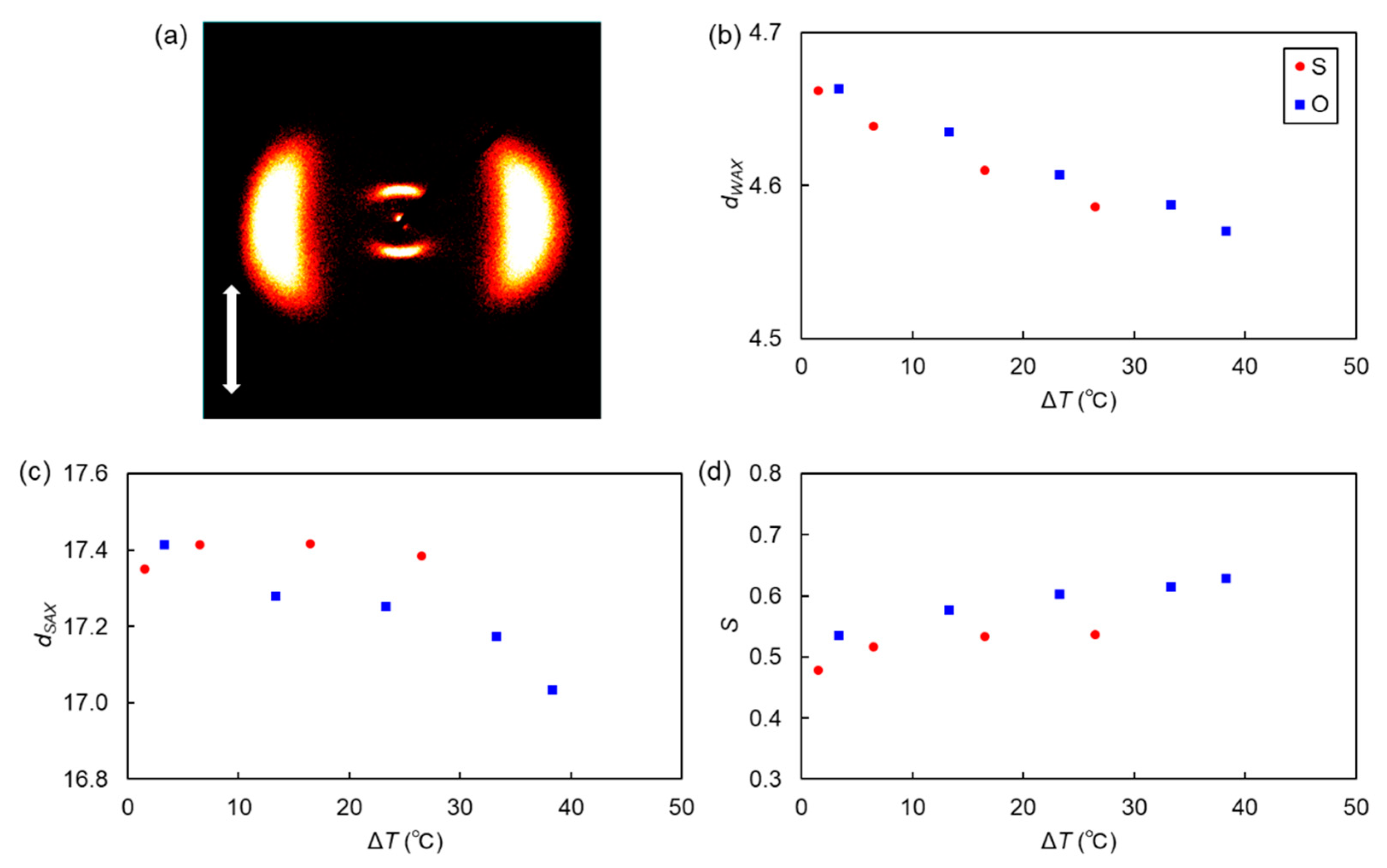Thioether-Linked Liquid Crystal Trimers: Odd–Even Effects of Spacers and the Influence of Thioether Bonds on Phase Behavior
Abstract
:1. Introduction


2. Materials and Methods
3. Results and Discussion
3.1. Phase-Transition Behavior of CBSnOBOnSCB
3.2. Comparison of CBSnOBOnSCB and CBOnOBOnOCB
3.2.1. Phase-Transition Behavior
3.2.2. Mesophase Structures
4. Conclusions
Supplementary Materials
Author Contributions
Funding
Institutional Review Board Statement
Informed Consent Statement
Data Availability Statement
Acknowledgments
Conflicts of Interest
References
- Imrie, C.T.; Henderson, P.A. Liquid crystal dimers and higher oligomers: Between monomers and polymers. Chem. Soc. Rev. 2007, 36, 2096–2124. [Google Scholar] [CrossRef] [PubMed]
- Emsley, J.W.; Luckhurst, G.R.; Shilstone, G.N.; Sage, I. The preparation and properties of the α, ω-bis (4, 4′-cyanobiphenyloxy) alkanes: Nematogenic molecules with a flexible core. Mol. Cryst. Liq. Cryst. 1984, 102, 223–233. [Google Scholar] [CrossRef]
- Barnes, P.J.; Douglass, A.G.; Heeks, S.K.; Luckhurst, G.R. An enhanced odd-even effect of liquid crystal dimers orientational order in the α, ω-bis (4′-cyanobiphenyl-4-yl) alkanes. Liq. Cryst. 1993, 13, 603–613. [Google Scholar] [CrossRef]
- Marcelis, A.T.; Koudijs, A.; Sudhölter, E.J. Odd-even effects in the thermotropic and optical properties of three series of chiral twin liquid crystals. Liq. Cryst. 1995, 18, 843–850. [Google Scholar] [CrossRef]
- Yoshida, T.; Sugimoto, A.; Ikoma, A.; Matsuoka, T.; Kang, S.; Sakajiri, K.; Watanabe, J.; Tokita, M. Odd–even effect on viscoelastic properties of twin-dimer nematic liquid crystals. Liq. Cryst. 2015, 42, 463–472. [Google Scholar] [CrossRef]
- Arakawa, Y.; Sasaki, S.; Igawa, K.; Tokita, M.; Konishi, G.; Tsuji, H. Birefringence and photoluminescence properties of diphenylacetylene-based liquid crystal dimers. New J. Chem. 2020, 44, 17531–17541. [Google Scholar] [CrossRef]
- Watanabe, J.; Komura, H.; Niori, T. Thermotropic liquid crystals of polyesters having a mesogenic 4, 4-bibenzoate unit smectic mesophase properties and structures in dimeric model compounds. Liq. Cryst. 1993, 13, 455–465. [Google Scholar] [CrossRef]
- Niori, T.; Adachi, S.; Watanabe, J. Smectic mesophase properties of dimeric compounds. 1. Dimeric compounds based on the mesogenic azobenzene unit. Liq. Cryst. 1995, 19, 139–148. [Google Scholar] [CrossRef]
- Dozov, I. On the spontaneous symmetry breaking in the mesophases of achiral banana-shaped molecules. Europhys. Lett. 2001, 56, 247–253. [Google Scholar] [CrossRef]
- Memmer, R. Liquid crystal phases of achiral banana-shaped molecules: A computer simulation study. Liq. Cryst. 2002, 29, 483–496. [Google Scholar] [CrossRef]
- Panov, V.P.; Nagaraj, M.; Vij, J.K.; Panarin, Y.P.; Kohlmeier, A.; Tamba, M.G.; Lewis, R.A.; Mehl, G.H. Spontaneous periodic deformations in nonchiral planar-aligned bimesogens with a nematic-nematic transition and a negative elastic constant. Phys. Rev. Lett. 2010, 105, 167801. [Google Scholar] [CrossRef] [PubMed] [Green Version]
- Cestari, M.; Diez-Berart, S.; Dunmur, D.A.; Ferrarini, A.; De La Fuente, M.R.; Jackson, D.J.B.; Lopez, D.O.; Luckhurst, G.R.; Perez-Jubindo, M.A.; Richardson, R.M.; et al. Phase behavior and properties of the liquid-crystal dimer 1′′, 7′′-bis (4-cyanobiphenyl-4′-yl) heptane: A twist-bend nematic liquid crystal. Phys. Rev. E 2011, 84, 031704. [Google Scholar] [CrossRef] [PubMed] [Green Version]
- Chen, D.; Porada, J.H.; Hooper, J.B.; Klittnick, A.; Shen, Y.; Tuchband, M.R.; Korblova, E.; Bedrov, D.; Walba, D.M.; Glaser, M.A.; et al. Chiral heliconical ground state of nanoscale pitch in a nematic liquid crystal of achiral molecular dimers. Proc. Natl. Acad. Sci. USA 2013, 110, 15931–15936. [Google Scholar] [CrossRef] [PubMed] [Green Version]
- Borshch, V.; Kim, Y.K.; Xiang, J.; Gao, M.; Jákli, A.; Panov, V.P.; Vij, J.K.; Imrie, C.T.; Tamba, M.G.; Mehl, G.H.; et al. Nematic twist-bend phase with nanoscale modulation of molecular orientation. Nat. Commun. 2013, 4, 2635. [Google Scholar] [CrossRef] [Green Version]
- Zhu, C.; Tuchband, M.R.; Young, A.; Shuai, M.; Scarbrough, A.; Walba, D.M.; Maclennan, J.E.; Wang, C.; Hexemer, A.; Clark, N.A. Resonant carbon K-edge soft X-ray scattering from lattice-free heliconical molecular ordering: Soft dilative elasticity of the twist-bend liquid crystal phase. Phys. Rev. Lett. 2016, 116, 147803. [Google Scholar] [CrossRef] [PubMed] [Green Version]
- Salili, S.M.; Kim, C.; Sprunt, S.; Gleeson, J.T.; Parri, O.; Jákli, A. Flow properties of a twist-bend nematic liquid crystal. RSC Adv. 2014, 4, 57419–57423. [Google Scholar] [CrossRef]
- Challa, P.K.; Borshch, V.; Parri, O.; Imrie, C.T.; Sprunt, S.N.; Gleeson, J.T.; Lavrentovich, O.D.; Jákli, A. Twist-bend nematic liquid crystals in high magnetic fields. Phys. Rev. E 2014, 89, 060501. [Google Scholar] [CrossRef] [Green Version]
- Gorecka, E.; Vaupotič, N.; Zep, A.; Pociecha, D.; Yoshioka, J.; Yamamoto, J.; Takezoe, H. A Twist-Bend Nematic (NTB) Phase of Chiral Materials. Angew. Chem. Int. Ed. 2015, 54, 10155–10159. [Google Scholar] [CrossRef]
- Zhou, J.; Tang, W.; Arakawa, Y.; Tsuji, H.; Aya, S. Viscoelastic properties of a thioether-based heliconical twist–bend nematogen. Phys. Chem. Chem. Phys. 2020, 22, 9593–9599. [Google Scholar] [CrossRef]
- Kumar, M.P.; Kula, P.; Dhara, S. Smecticlike rheology and pseudolayer compression elastic constant of a twist-bend nematic liquid crystal. Phys. Rev. Mater. 2020, 4, 115601. [Google Scholar] [CrossRef]
- Meyer, C.; Luckhurst, G.R.; Dozov, I. The temperature dependence of the heliconical tilt angle in the twist-bend nematic phase of the odd dimer CB7CB. J. Mater. Chem. C 2015, 3, 318–328. [Google Scholar] [CrossRef]
- Sebastián, N.; López, D.O.; Robles-Hernández, B.; de la Fuente, M.R.; Salud, J.; Pérez-Jubindo, M.A.; Dunmur, D.A.; Luckhurst, G.R.; Jackson, D.J.B. Dielectric, calorimetric and mesophase properties of 1′′-(2′, 4-difluorobiphenyl-4′-yloxy)-9′′-(4-cyanobiphenyl-4′-yloxy) nonane: An odd liquid crystal dimer with a monotropic mesophase having the characteristics of a twist-bend nematic phase. Phys. Chem. Chem. Phys. 2014, 16, 21391–21406. [Google Scholar] [CrossRef] [PubMed]
- Paterson, D.A.; Xiang, J.; Singh, G.; Walker, R.; Agra-Kooijman, D.M.; Martínez-Felipe, A.; Gao, M.; Storey, J.M.D.; Kumar, S.; Lavrentovich, O.D.; et al. Reversible isothermal twist–bend nematic–nematic phase transition driven by the photoisomerization of an azobenzene-based nonsymmetric liquid crystal dimer. J. Am. Chem. Soc. 2016, 138, 5283–5289. [Google Scholar] [CrossRef] [PubMed]
- Panov, V.P.; Sreenilayam, S.P.; Panarin, Y.P.; Vij, J.K.; Welch, C.J.; Mehl, G.H. Characterization of the submicrometer hierarchy levels in the twist-bend nematic phase with nanometric helices via photopolymerization. Explanation for the sign reversal in the polar response. Nano Lett. 2017, 17, 7515–7519. [Google Scholar] [CrossRef] [Green Version]
- Prasad, S.K.; Madhuri, P.L.; Satapathy, P.; Yelamaggad, C.V. A soft-bent dimer composite exhibiting twist-bend nematic phase: Photo-driven effects and an optical memory device. Appl. Phys. Lett. 2018, 112, 253701. [Google Scholar] [CrossRef]
- Merkel, K.; Kocot, A.; Vij, J.K.; Shanker, G. Distortions in structures of the twist bend nematic phase of a bent-core liquid crystal by the electric field. Phys. Rev. E 2018, 98, 022704. [Google Scholar] [CrossRef] [Green Version]
- Aya, S.; Salamon, P.; Paterson, D.A.; Storey, J.M.; Imrie, C.T.; Araoka, F.; Jákli, A.; Buka, Á. Fast-and-giant photorheological effect in a liquid crystal dimer. Adv. Mater. Interfaces 2019, 6, 1802032. [Google Scholar] [CrossRef] [Green Version]
- Feng, C.; Feng, J.; Saha, R.; Arakawa, Y.; Gleeson, J.; Sprunt, S.; Zhu, C.; Jákli, A. Manipulation of the nanoscale heliconical structure of a twist-bend nematic material with polarized light. Phys. Rev. Res. 2020, 2, 032004. [Google Scholar] [CrossRef]
- Stevenson, W.D.; Zeng, X.; Welch, C.; Thakur, A.K.; Ungar, G.; Mehl, G.H. Macroscopic chirality of twist-bend nematic phase in bent dimers confirmed by circular dichroism. J. Mater. Chem. C 2020, 8, 1041–1047. [Google Scholar] [CrossRef]
- Merkel, K.; Loska, B.; Welch, C.; Mehl, G.H.; Kocot, A. Molecular biaxiality determines the helical structure–infrared measurements of the molecular order in the nematic twist-bend phase of difluoro terphenyl dimer. Phys. Chem. Chem. Phys. 2021, 23, 4151–4160. [Google Scholar] [CrossRef]
- Cao, Y.; Feng, J.; Nallapaneni, A.; Arakawa, Y.; Zhao, K.; Zhang, H.; Mehl, G.H.; Zhu, C.; Liu, F. Deciphering helix assembly in the heliconical nematic phase via tender resonant X-ray scattering. J. Mater. Chem. C 2021, 9, 10020–10028. [Google Scholar] [CrossRef]
- Varshini, G.V.; Rao, D.S.; Hiremath, U.S.; Yelamaggad, C.V.; Prasad, S.K. Dielectric and viscoelastic investigations in a binary system of soft-and rigid-bent mesogens exhibiting the twist-bend nematic phase. J. Mol. Liq. 2021, 323, 114987. [Google Scholar] [CrossRef]
- Vanakaras, A.G.; Photinos, D.J. A molecular theory of nematic–nematic phase transitions in mesogenic dimers. Soft Matter 2016, 12, 2208–2220. [Google Scholar] [CrossRef] [PubMed] [Green Version]
- Heist, L.M.; Samulski, E.T.; Welch, C.; Ahmed, Z.; Mehl, G.H.; Vanakaras, A.G.; Photinos, D.J. Probing molecular ordering in the nematic phases of para-linked bimesogen dimers through NMR studies of flexible prochiral solutes. Liq. Cryst. 2020, 47, 2058–2073. [Google Scholar] [CrossRef] [Green Version]
- Samulski, E.T.; Reyes-Arango, D.; Vanakaras, A.G.; Photinos, D.J. All Structures Great and Small: Nanoscale Modulations in Nematic Liquid Crystals. Nanomaterials 2022, 12, 93. [Google Scholar] [CrossRef]
- Henderson, P.A.; Imrie, C. T Methylene-linked liquid crystal dimers and the twist-bend nematic phase. Liq. Cryst. 2011, 38, 1407–1414. [Google Scholar] [CrossRef]
- Zep, A.; Aya, S.; Aihara, K.; Ema, K.; Pociecha, D.; Madrak, K.; Bernatowicz, P.; Takezoe, H.; Gorecka, E. Multiple nematic phases observed in chiral mesogenic dimers. J. Mater. Chem. C 2013, 1, 46–49. [Google Scholar] [CrossRef]
- Ahmed, Z.; Welch, C.; Mehl, G.H. The design and investigation of the self-assembly of dimers with two nematic phases. RSC Adv. 2015, 5, 93513–93521. [Google Scholar] [CrossRef] [Green Version]
- Tamba, M.G.; Salili, S.M.; Zhang, C.; Jákli, A.; Mehl, G.H.; Stannarius, R.; Eremin, A. A fibre forming smectic twist–bent liquid crystalline phase. RSC Adv. 2015, 5, 11207–11211. [Google Scholar] [CrossRef] [Green Version]
- Mandle, R.J.; Goodby, J.W. Does Topology Dictate the Incidence of the Twist-Bend Phase? Insights Gained from Novel Unsymmetrical Bimesogens. Chem. Eur. J. 2016, 22, 18456–18464. [Google Scholar] [CrossRef]
- Dawood, A.A.; Grossel, M.C.; Luckhurst, G.R.; Richardson, R.M.; Timimi, B.A.; Wells, N.J.; Yousif, Y.Z. On the twist-bend nematic phase formed directly from the isotropic phase. Liq. Cryst. 2016, 43, 2–12. [Google Scholar] [CrossRef] [Green Version]
- Mandle, R.J.; Archbold, C.T.; Sarju, J.P.; Andrews, J.L.; Goodby, J.W. The dependency of nematic and twist-bend mesophase formation on bend angle. Sci. Rep. 2016, 6, 36682. [Google Scholar] [CrossRef] [PubMed] [Green Version]
- Ivšić, T.; Baumeister, U.; Dokli, I.; Mikleušević, A.; Lesac, A. Sensitivity of the NTB phase formation to the molecular structure of imino-linked dimers. Liq. Cryst. 2017, 44, 93–105. [Google Scholar]
- Knežević, A.; Sapunar, M.; Buljan, A.; Dokli, I.; Hameršak, Z.; Kontrec, D.; Lesac, A. Fine-tuning the effect of π–π interactions on the stability of the NTB phase. Soft Matter 2018, 14, 8466–8474. [Google Scholar] [CrossRef]
- Watanabe, K.; Tamura, T.; Kang, S.; Tokita, M. Twist bend nematic liquid crystals prepared by one-step condensation of 4-(4-Pentylcyclohexyl) benzoic acid and alkyl diol. Liq. Cryst. 2018, 45, 924–930. [Google Scholar] [CrossRef]
- Walker, R.; Pociecha, D.; Storey, J.M.D.; Gorecka, E.; Imrie, C.T. The chiral twist-bend nematic phase (N*TB). Chem. Eur. J. 2019, 25, 13329–13335. [Google Scholar] [CrossRef]
- Mandle, R.J.; Goodby, J.W. Molecular Flexibility and Bend in Semi-Rigid Liquid Crystals: Implications for the Heliconical Nematic Ground State. Chem. Eur. J. 2019, 25, 14454–14459. [Google Scholar] [CrossRef]
- Zep, A.; Pruszkowska, K.; Dobrzycki, Ł.; Sektas, K.; Szałański, P.; Marek, P.H.; Cyrański, M.K.; Sicinski, R.R. Cholesterol-based photo-switchable mesogenic dimers. Strongly bent molecules versus an intercalated structure. CrystEngComm 2019, 21, 2779–2789. [Google Scholar] [CrossRef]
- Knežević, A.; Dokli, I.; Novak, J.; Kontrec, D.; Lesac, A. Fluorinated twist-bend nematogens: The role of intermolecular interaction. Liq. Cryst. 2021, 48, 756–766. [Google Scholar] [CrossRef]
- Wang, Y.; Singh, G.; Agra-Kooijman, D.M.; Gao, M.; Bisoyi, H.K.; Xue, C.; Fisch, M.R.; Kumar, S.; Li, Q. Room temperature heliconical twist-bend nematic liquid crystal. CrystEngComm 2015, 17, 2778–2782. [Google Scholar] [CrossRef]
- Jansze, S.M.; Martínez-Felipe, A.; Storey, J.M.; Marcelis, A.T.; Imrie, C.T. A twist-bend nematic phase driven by hydrogen bonding. Angew. Chem. 2015, 127, 653–656. [Google Scholar] [CrossRef]
- Mandle, R.J.; Goodby, J.W. A Liquid Crystalline Oligomer Exhibiting Nematic and Twist-Bend Nematic Mesophases. ChemPhysChem 2016, 17, 967–970. [Google Scholar] [CrossRef] [PubMed]
- Mandle, R.J.; Goodby, J.W. Progression from nano to macro science in soft matter systems: Dimers to trimers and oligomers in twist-bend liquid crystals. RSC Adv. 2016, 6, 34885–34893. [Google Scholar] [CrossRef] [Green Version]
- Saha, R.; Babakhanova, G.; Parsouzi, Z.; Rajabi, M.; Gyawali, P.; Welch, C.; Mehl, G.H.; Gleeson, J.; Lavrentovich, O.D.; Sprunt, S.; et al. Oligomeric odd–even effect in liquid crystals. Mater. Horiz. 2019, 6, 1905–1912. [Google Scholar] [CrossRef]
- Stevenson, W.D.; An, J.; Zeng, X.B.; Xue, M.; Zou, H.X.; Liu, Y.S.; Ungar, G. Twist-bend nematic phase in biphenylethane-based copolyethers. Soft Matter 2018, 14, 3003–3011. [Google Scholar] [CrossRef] [Green Version]
- Chen, D.; Nakata, M.; Shao, R.; Tuchband, M.R.; Shuai, M.; Baumeister, U.; Weissflog, W.; Walba, D.M.; Glaser, M.A.; Maclennan, J.E.; et al. Twist-bend heliconical chiral nematic liquid crystal phase of an achiral rigid bent-core mesogen. Phys. Rev. E 2014, 89, 022506. [Google Scholar] [CrossRef] [Green Version]
- Sreenilayam, S.P.; Panov, V.P.; Vij, J.K.; Shanker, G. The NTB phase in an achiral asymmetrical bent-core liquid crystal terminated with symmetric alkyl chains. Liq. Cryst. 2017, 44, 244–253. [Google Scholar] [CrossRef] [Green Version]
- Arakawa, Y.; Komatsu, K.; Shiba, T.; Tsuji, H. Phase behaviors of classic liquid crystal dimers and trimers: Alternate induction of smectic and twist-bend nematic phases depending on spacer parity for liquid crystal trimers. J. Mol Liq. 2021, 326, 115319. [Google Scholar] [CrossRef]
- Furuya, H.; Asahi, K.; Abe, A. An odd–even effect in the mesophasic behavior of dimer liquid crystals due to the bond orientation of a phenylene unit incorporated in the flexible spacer. Polym. J. 1986, 18, 779–782. [Google Scholar] [CrossRef] [Green Version]
- Zuev, V.V. Synthesis of Bis (4-cyanobiphenyloxyalkyloxy)-4, 4′-biphenyls, the Liquid-Crystalline Trimers. Russ. J. Gen. Chem. 1997, 67, 1791–1793. [Google Scholar]
- Imrie, C.T.; Luckhurst, G.R. Liquid crystal trimers. The synthesis and characterisation of the4, 4′-bis [ω-(4-cyanobiphenyl-4′-yloxy) alkoxy] biphenyls. J. Mater. Chem. 1998, 8, 1339–1343. [Google Scholar] [CrossRef]
- Arakawa, Y.; Komatsu, K.; Inui, S.; Tsuji, H. Thioether-linked liquid crystal dimers and trimers: The twist-bend nematic phase. J. Mol. Struct. 2020, 1199, 126913. [Google Scholar] [CrossRef]
- Arakawa, Y.; Komatsu, K.; Tsuji, H. 2,7-substituted fluorenone-based liquid crystal trimers: Twist-bend nematic phase induced by outer thioether linkage. 2022. [Google Scholar] [CrossRef]
- Kleinpeter, E.; Köhler, H.; Lunow, A.; Tschierske, C.; Zaschke, H. Liquid-crystalline behaviour of 2, 5-disubstituted 1, 3-dioxanes subject to the flexibility of terminal chains. Tetrahedron 1988, 44, 1609–1612. [Google Scholar] [CrossRef]
- Arakawa, Y.; Kang, S.; Tsuji, H.; Watanabe, J.; Konishi, G. Development of novel bistolane-based liquid crystalline molecules with an alkylsulfanyl group for highly birefringent materials. RSC Adv. 2016, 6, 16568–16574. [Google Scholar] [CrossRef]
- Arakawa, Y.; Sasaki, Y.; Igawa, K.; Tsuji, H. Hydrogen bonding liquid crystalline benzoic acids with alkylthio groups: Phase transition behavior and insights into the cybotactic nematic phase. New J. Chem. 2017, 41, 6514–6522. [Google Scholar] [CrossRef]
- Arakawa, Y.; Tsuji, H. Phase transitions and birefringence of bistolane-based nematic molecules with an alkyl, alkoxy and alkylthio group. Mol. Cryst. Liq. Cryst. 2017, 647, 422–429. [Google Scholar] [CrossRef]
- Arakawa, Y.; Komatsu, K.; Tsuji, H. Twist-bend nematic liquid crystals based on thioether linkage. New J. Chem. 2019, 43, 6786–6793. [Google Scholar] [CrossRef]
- Cruickshank, E.; Salamończyk, M.; Pociecha, D.; Strachan, G.J.; Storey, J.M.; Wang, C.; Feng, J.; Zhu, C.; Gorecka, E.; Imrie, C.T. Sulfur-linked cyanobiphenyl-based liquid crystal dimers and the twist-bend nematic phase. Liq. Cryst. 2019, 46, 1595–1609. [Google Scholar] [CrossRef] [Green Version]
- Arakawa, Y.; Ishida, Y.; Tsuji, H. Ether-and Thioether-Linked Naphthalene-Based Liquid-Crystal Dimers: Influence of Chalcogen Linkage and Mesogenic-Arm Symmetry on the Incidence and Stability of the Twist–Bend Nematic Phase. Chem. Eur. J. 2020, 26, 3767–3775. [Google Scholar] [CrossRef]
- Arakawa, Y.; Komatsu, K.; Feng, J.; Zhu, C.; Tsuji, H. Distinct twist-bend nematic phase behaviors associated with the ester-linkage direction of thioether-linked liquid crystal dimers. Mater. Adv. 2021, 2, 261–272. [Google Scholar] [CrossRef]
- Arakawa, Y.; Komatsu, K.; Shiba, T.; Tsuji, H. Methylene-and thioether-linked cyanobiphenyl-based liquid crystal dimers CB n SCB exhibiting room temperature twist-bend nematic phases and glasses. Mater. Adv. 2021, 2, 1760–1773. [Google Scholar] [CrossRef]
- Arakawa, Y.; Komatsu, K.; Ishida, Y.; Igawa, K.; Tsuji, H. Carbonyl-and thioether-linked cyanobiphenyl-based liquid crystal dimers exhibiting twist-bend nematic phases. Tetrahedron 2021, 81, 131870. [Google Scholar] [CrossRef]
- Arakawa, Y.; Ishida, Y.; Komatsu, K.; Arai, Y.; Tsuji, H. Thioether-linked benzylideneaniline-based twist-bend nematic liquid crystal dimers: Insights into spacer lengths, mesogenic arm structures, and linkage types. Tetrahedron 2021, 95, 132351. [Google Scholar] [CrossRef]
- Arakawa, Y.; Tsuji, H. Selenium-linked liquid crystal dimers for twist-bend nematogens. J. Mol. Liq. 2019, 289, 111097. [Google Scholar] [CrossRef]
- Mandle, R.J.; Goodby, J.W. A Nanohelicoidal Nematic Liquid Crystal Formed by a Non-Linear Duplexed Hexamer. Angew. Chem. Int. Ed. 2018, 57, 7096–7100. [Google Scholar] [CrossRef]
- Arakawa, Y.; Inui, S.; Tsuji, H. Synthesis and characterization of alkylthio-attached azobenzene-based liquid crystal polymers: Roles of the alkylthio bond and polymer chain in phase behavior and liquid crystal formation. Polymer 2021, 233, 124194. [Google Scholar] [CrossRef]
- Vries, A.D. X-ray photographic studies of liquid crystals I. A cybotactic nematic phase. Mol. Cryst. Liq. Cryst. 1970, 10, 219–236. [Google Scholar] [CrossRef]
- Tschierske, C.; Photinos, D.J. Biaxial nematic phases. J. Mater. Chem. 2010, 20, 4263–4294. [Google Scholar] [CrossRef]





| n | Cr | Tm (°C) | ΔSm/R | - | - | N | TNI (°C) | ΔSNI/R | I |
|---|---|---|---|---|---|---|---|---|---|
| TCr (°C) | ΔSCr/R | Monotropic SmA or NTB a | TNS or TNNTB (°C) | TIN (°C) | ΔSIN/R | ||||
| 3 | • | 186.4 | 20.9 | • | |||||
| • | 144.8 | 19.6 | • | 142 a | - | • | |||
| 4 | • | 235.3 | 12.5 | • | 253.2 | 2.8 | • | ||
| • | 196.6 | 11.9 | • | 249.5 | 3.1 | • | |||
| 5 | • | 171.8 | 22.5 | • | |||||
| • | 133.6 | 19.7 | NTB | 117 a | • | 154.2 | 0.4 | • | |
| 6 | • | 219.0 | 24.7 | • | |||||
| • | 200.9 | 14.9 | SmA | 180 a | • | 217.4 | 4.0 | • | |
| 7 b | • | 149.4 | 20.7 | • | 162.4 | 0.8 | • | ||
| • | 130.0 | 20.6 | NTB | 126 a | • | 160.2 | 0.7 | • | |
| 8 | • | 195.6 | 31.1 d | • | 198.8 | - d | • | ||
| • | 168.6 | 13.2 | SmA | 167 a | • | 195.0 | 4.3 | • | |
| 9 c | • | 131.3 | 21.5 | • | 158.8 | 1.1 | • | ||
| • | 103.6 | 20.3 | NTB | 122.7 | • | 156.5 | 1.1 | • | |
| 10 | • | 184.8 | 32.8 | • | |||||
| • | 150.7 | 25.5 | SmA | 146 a | • | 176.2 | 4.9 | • | |
| 11 | • | 135.4 | 29.2 | • | 154.0 | 1.7 | • | ||
| • | 116.6 | 25.2 | NTB | 121 a | • | 151.5 | 1.7 | • |
Publisher’s Note: MDPI stays neutral with regard to jurisdictional claims in published maps and institutional affiliations. |
© 2022 by the authors. Licensee MDPI, Basel, Switzerland. This article is an open access article distributed under the terms and conditions of the Creative Commons Attribution (CC BY) license (https://creativecommons.org/licenses/by/4.0/).
Share and Cite
Arakawa, Y.; Komatsu, K.; Ishida, Y.; Shiba, T.; Tsuji, H. Thioether-Linked Liquid Crystal Trimers: Odd–Even Effects of Spacers and the Influence of Thioether Bonds on Phase Behavior. Materials 2022, 15, 1709. https://doi.org/10.3390/ma15051709
Arakawa Y, Komatsu K, Ishida Y, Shiba T, Tsuji H. Thioether-Linked Liquid Crystal Trimers: Odd–Even Effects of Spacers and the Influence of Thioether Bonds on Phase Behavior. Materials. 2022; 15(5):1709. https://doi.org/10.3390/ma15051709
Chicago/Turabian StyleArakawa, Yuki, Kenta Komatsu, Yuko Ishida, Takuma Shiba, and Hideto Tsuji. 2022. "Thioether-Linked Liquid Crystal Trimers: Odd–Even Effects of Spacers and the Influence of Thioether Bonds on Phase Behavior" Materials 15, no. 5: 1709. https://doi.org/10.3390/ma15051709







